Abstract
We prepared a brominated poly(dG-dC).poly(dG-dC) which forms a stable Z-DNA helix under physiological salt conditions. Rabbits and mice were immunized with brominated and unbrominated poly(dG-dC).poly(dG-dC) complexed with methylated bovine serum albumin. Antibodies specific for Z-DNA were produced. These antibodies were found not only in the sera of animals immunized with the low-salt stabilized Z-DNA [Br-poly(dG-dC).poly(dG-dC)] but also in sera from animals immunized with the unbrominated B-DNA form of the polymer. From this it is inferred that the unbrominated poly(dG-dC).poly(dG-dC) was partially converted to Z-DNA by its combination with the basic protein methylated bovine serum albumin. In addition to specific anti-Z-DNA antibody populations, two other interesting types of antibody populations were found. One of these reacted with both the Z and B forms of poly(dG-dC).poly(dG-dC). This antibody may be converting the polymer from the B-DNA to the Z-DNA form. The other type of antibody was specific for a B form of poly(dG-dC).poly(dG-dC) and did not react at all with the Z form. The antibodies raised to Z-DNA were shown to be highly specific for Z-DNA and did not react with B-DNA, RNA, DNA.RNA hybrids, or a number of other polynucleotides. This specificity for Z-DNA will make possible their use as reagents for determining the presence of Z-DNA in biological systems. Sera of autoimmune lupus mice were also shown to have a considerable amount of naturally occurring anti-Z-DNA antibody activity.
Full text
PDF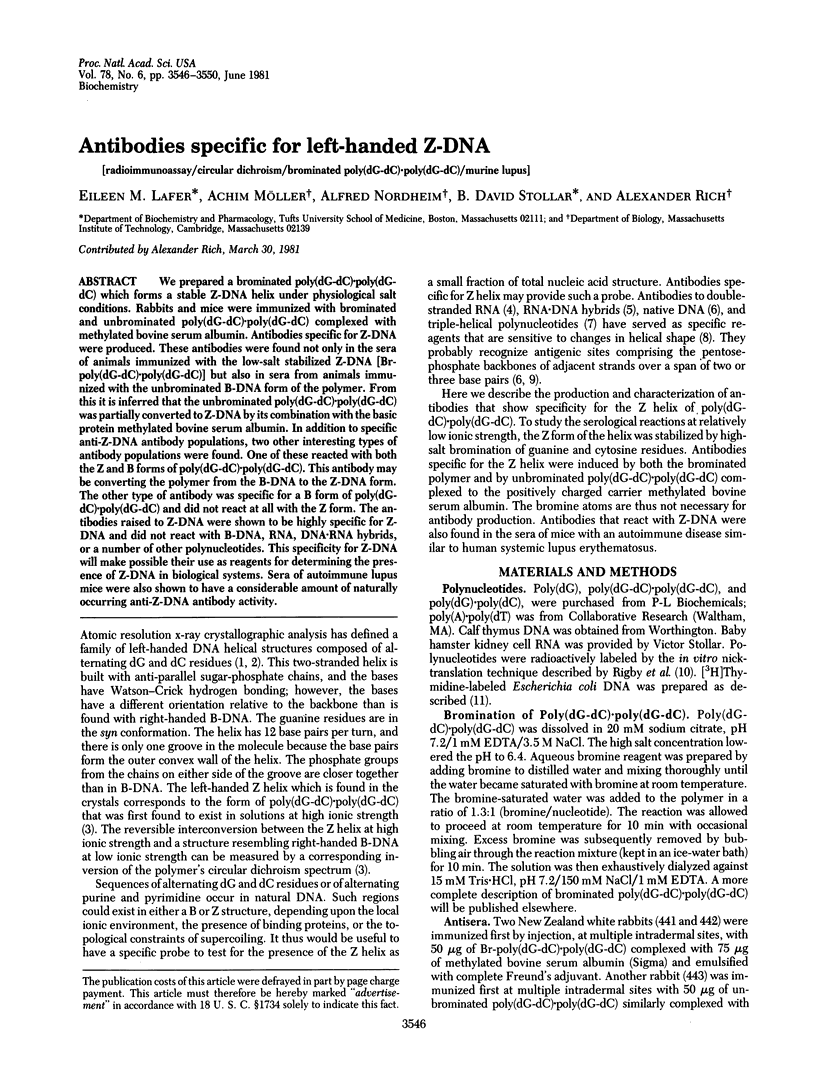
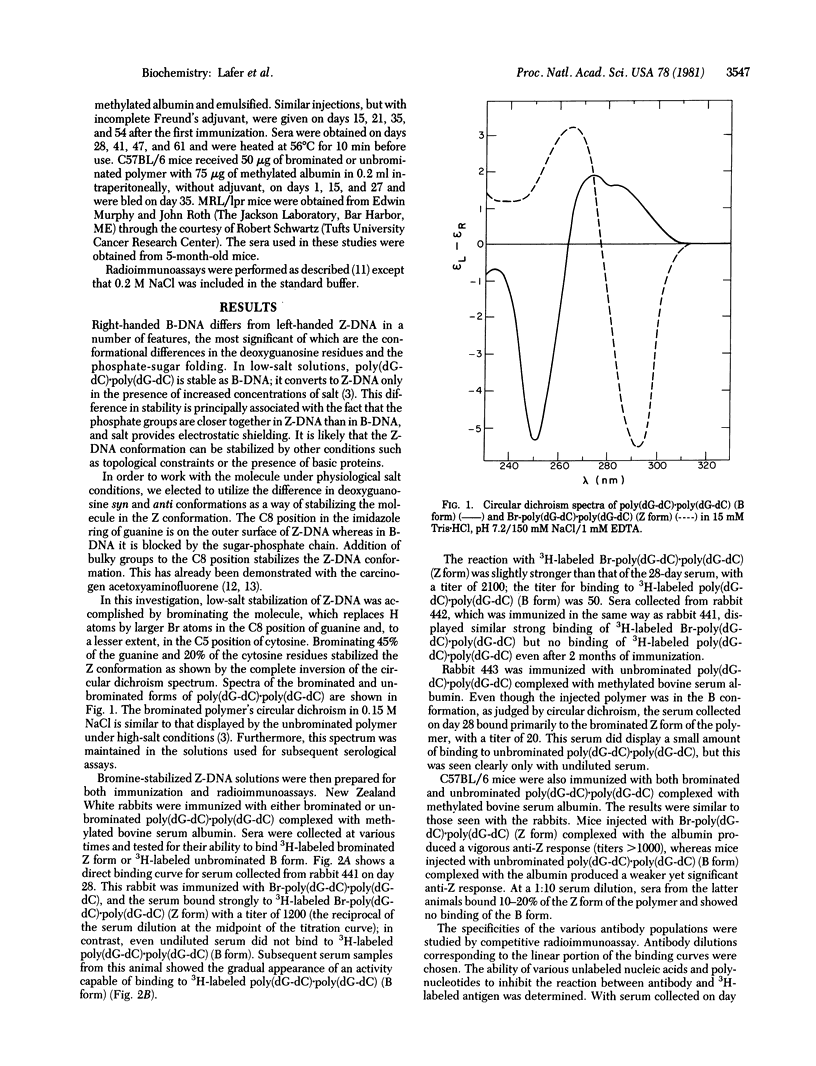
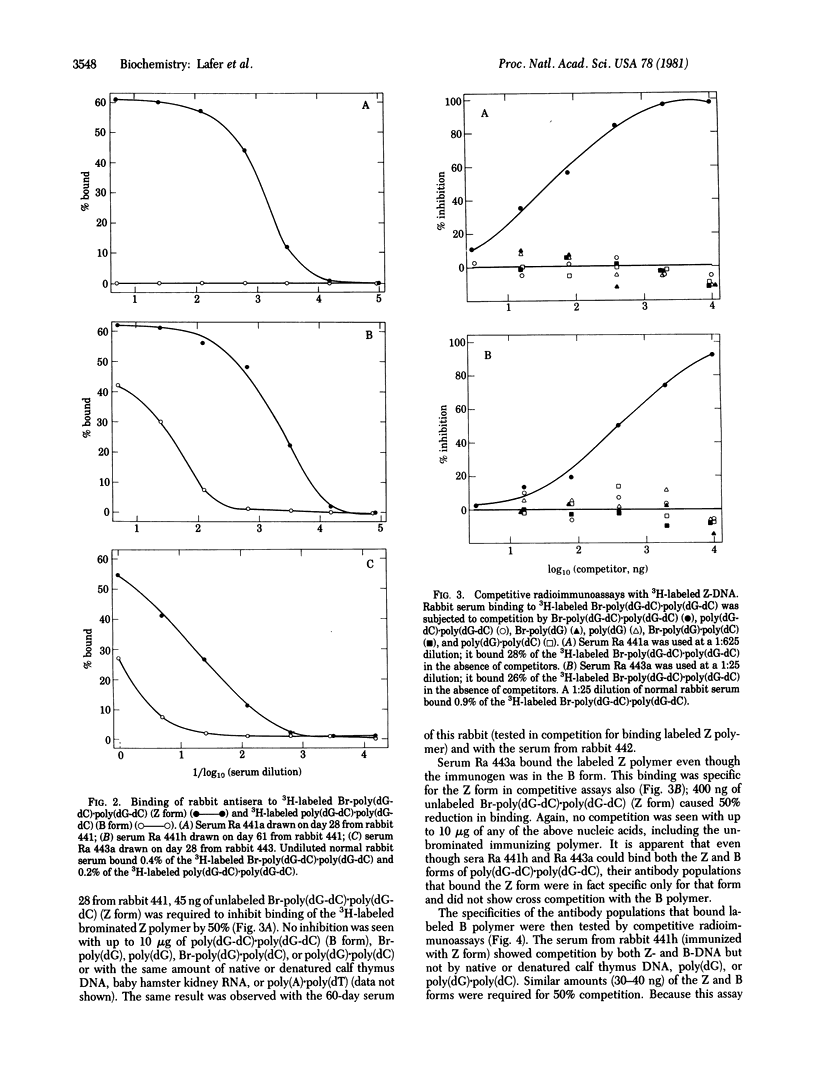
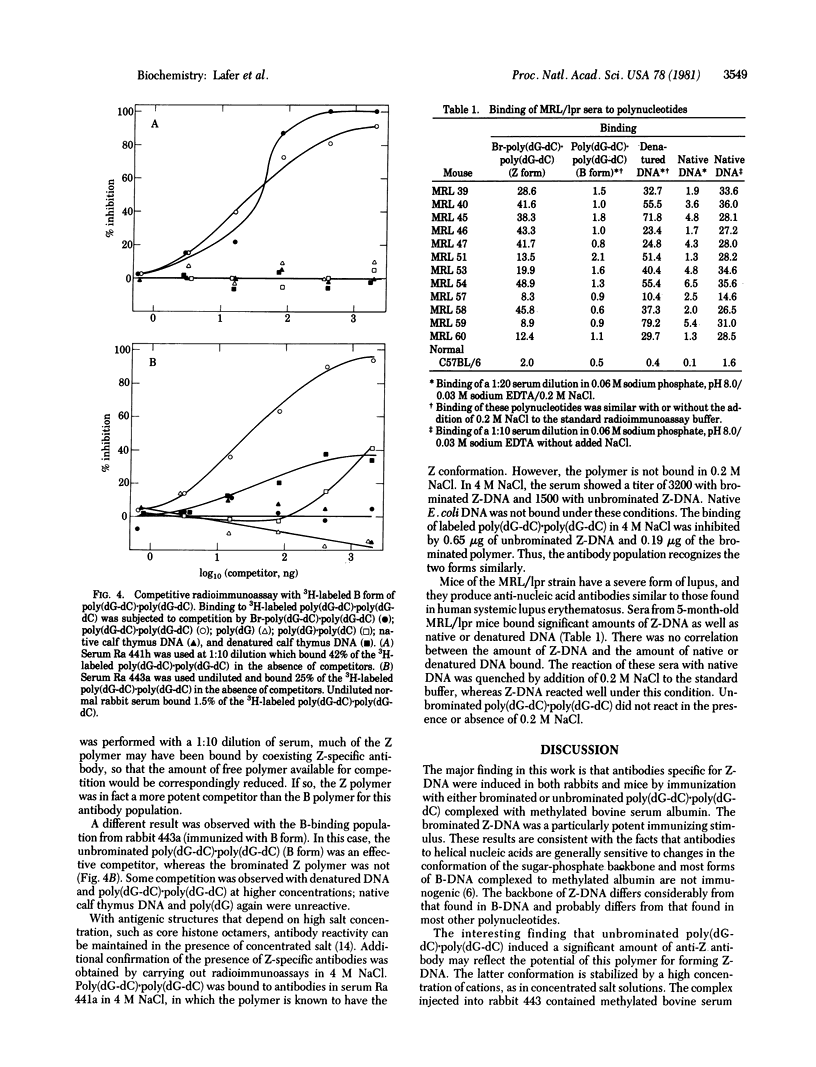
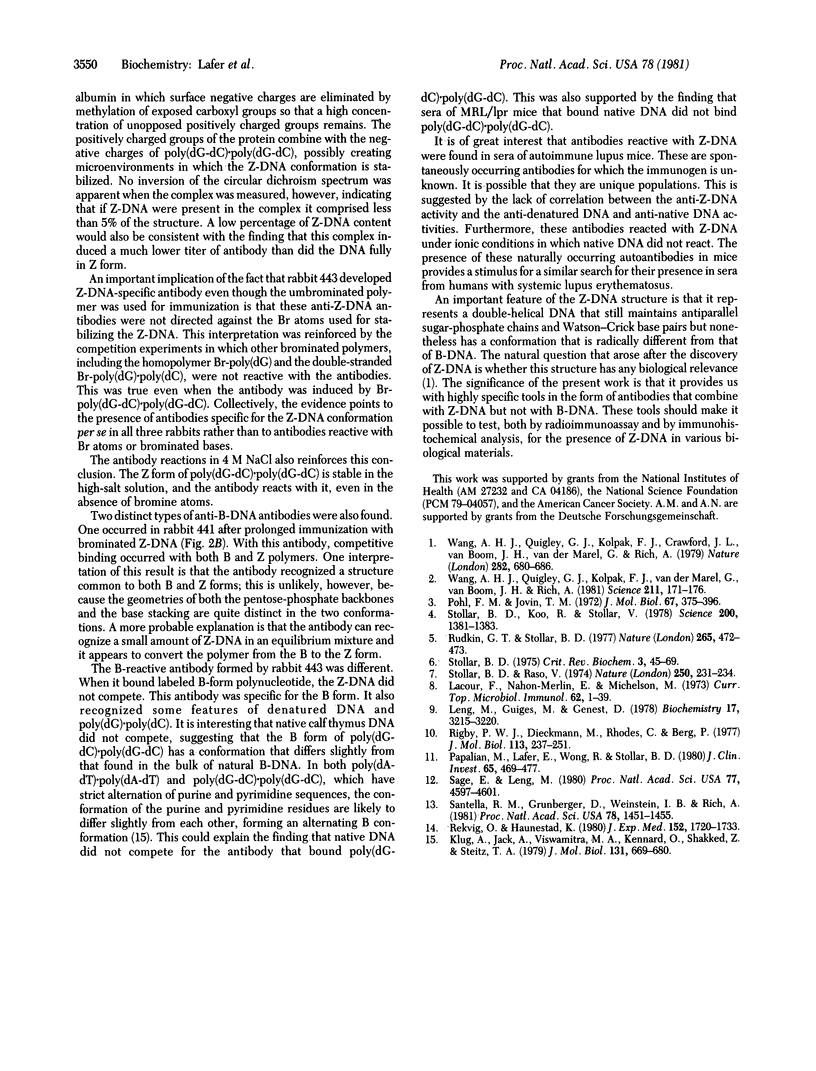
Selected References
These references are in PubMed. This may not be the complete list of references from this article.
- Klug A., Jack A., Viswamitra M. A., Kennard O., Shakked Z., Steitz T. A. A hypothesis on a specific sequence-dependent conformation of DNA and its relation to the binding of the lac-repressor protein. J Mol Biol. 1979 Jul 15;131(4):669–680. doi: 10.1016/0022-2836(79)90196-7. [DOI] [PubMed] [Google Scholar]
- Lacour F., Nahon-Merlin E., Michelson M. Immunological recognition of polynucleotide structure. Curr Top Microbiol Immunol. 1973;62:1–39. doi: 10.1007/978-3-642-65772-6_1. [DOI] [PubMed] [Google Scholar]
- Leng M., Guigues M., Genest D. Further studies on the interaction between polynucleotides and antibodies to poly(inosinic acid). poly(cytidylic acid). Biochemistry. 1978 Aug 8;17(16):3215–3220. doi: 10.1021/bi00609a007. [DOI] [PubMed] [Google Scholar]
- Papalian M., Lafer E., Wong R., Stollar B. D. Reaction of systemic lupus erythematosus antinative DNA antibodies with native DNA fragments from 20 to 1,200 base pairs. J Clin Invest. 1980 Feb;65(2):469–477. doi: 10.1172/JCI109690. [DOI] [PMC free article] [PubMed] [Google Scholar]
- Pohl F. M., Jovin T. M. Salt-induced co-operative conformational change of a synthetic DNA: equilibrium and kinetic studies with poly (dG-dC). J Mol Biol. 1972 Jun 28;67(3):375–396. doi: 10.1016/0022-2836(72)90457-3. [DOI] [PubMed] [Google Scholar]
- Rekvig O. P., Hannestad K. Human autoantibodies that react with both cell nuclei and plasma membranes display specificity for the octamer of histones H2A, H2B, H3, and H4 in high salt. J Exp Med. 1980 Dec 1;152(6):1720–1733. doi: 10.1084/jem.152.6.1720. [DOI] [PMC free article] [PubMed] [Google Scholar]
- Rigby P. W., Dieckmann M., Rhodes C., Berg P. Labeling deoxyribonucleic acid to high specific activity in vitro by nick translation with DNA polymerase I. J Mol Biol. 1977 Jun 15;113(1):237–251. doi: 10.1016/0022-2836(77)90052-3. [DOI] [PubMed] [Google Scholar]
- Rudkin G. T., Stollar B. D. High resolution detection of DNA-RNA hybrids in situ by indirect immunofluorescence. Nature. 1977 Feb 3;265(5593):472–473. doi: 10.1038/265472a0. [DOI] [PubMed] [Google Scholar]
- Sage E., Leng M. Conformation of poly(dG-dC) . poly(dG-dC) modified by the carcinogens N-acetoxy-N-acetyl-2-aminofluorene and N-hydroxy-N-2-aminofluorene. Proc Natl Acad Sci U S A. 1980 Aug;77(8):4597–4601. doi: 10.1073/pnas.77.8.4597. [DOI] [PMC free article] [PubMed] [Google Scholar]
- Santella R. M., Grunberger D., Weinstein I. B., Rich A. Induction of the Z conformation in poly(dG-dC).poly(dG-dC) by binding of N-2-acetylaminofluorene to guanine residues. Proc Natl Acad Sci U S A. 1981 Mar;78(3):1451–1455. doi: 10.1073/pnas.78.3.1451. [DOI] [PMC free article] [PubMed] [Google Scholar]
- Stollar B. D., Koo R., Stollar V. Immunofluorescent detection of nuclear double-stranded RNA in situ in Vero and mosquito cells. Science. 1978 Jun 23;200(4348):1381–1383. doi: 10.1126/science.26972. [DOI] [PubMed] [Google Scholar]
- Stollar B. D., Raso V. Antibodies recognise specific structures of triple-helical polynucleotides built on poly(A) or poly(dA). Nature. 1974 Jul 19;250(463):231–234. doi: 10.1038/250231a0. [DOI] [PubMed] [Google Scholar]
- Stollar B. D. The specificity and applications of antibodies to helical nucleic acids. CRC Crit Rev Biochem. 1975 May;3(1):45–69. doi: 10.3109/10409237509102552. [DOI] [PubMed] [Google Scholar]
- Wang A. H., Quigley G. J., Kolpak F. J., Crawford J. L., van Boom J. H., van der Marel G., Rich A. Molecular structure of a left-handed double helical DNA fragment at atomic resolution. Nature. 1979 Dec 13;282(5740):680–686. doi: 10.1038/282680a0. [DOI] [PubMed] [Google Scholar]
- Wang A. J., Quigley G. J., Kolpak F. J., van der Marel G., van Boom J. H., Rich A. Left-handed double helical DNA: variations in the backbone conformation. Science. 1981 Jan 9;211(4478):171–176. doi: 10.1126/science.7444458. [DOI] [PubMed] [Google Scholar]


